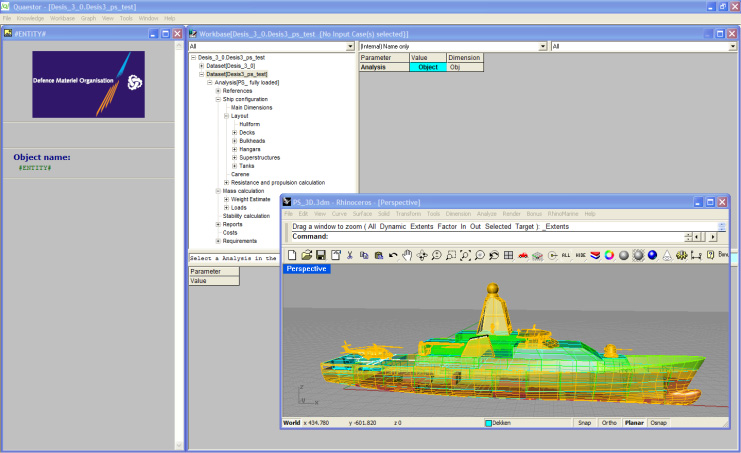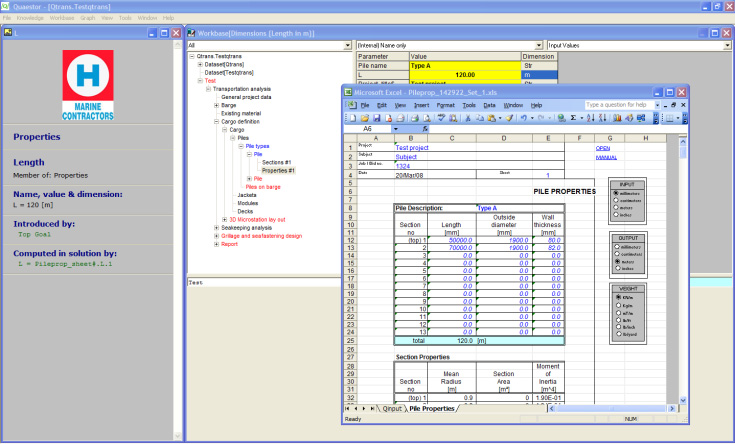This documentation relates to version 3.1
If you are using an earlier version, please view the previous versions of QUAESTOR documentation and select the relevant version.
This is the home of the QUAESTOR Documentation.
On the top level documentation can be found on:
Product information for QUAESTOR
Streamlining your design & engineering proces
Quaestor
Quaestor is a software environment to develop and use knowledge bases containing computational methods and data. The combination of a knowledge base and Quaestor makes a knowledge-based system. With these systems, you are able to streamline analysis, design and engineering processes.
Advantages
Knowledge-based systems in Quaestor enable research, engineering and design departments to simplify the tasks of:
- Managing computational methods and model fragments.
- Manage and use of complex workflows in addition to data and calculation management.
- Controlling design and engineering processes.
- Performing goal driven design, engineering and mathematical model development.
- Project administration (all information from project data to calculation results and reports in one environment).
Apart from the above features, Quaestor provides a flexible computational environment that allows:
- The concurrent use of various computational models and programs (formulas, rules, programs, spreadsheets).
- Computing solutions for problems with one or more varying independent parameters.
- Easy maintenance and rapid development of new applications by including new model fragments in a knowledge base.
- The use of legacy software, prediction tools, databases, spreadsheets and relations.
This makes Quaestor one of the most powerful environments currently available for the development and use of knowledge-based computational models, applications and configurators.
Examples
Examples of knowledge based systems developed in this way:
DeSIS 3
DeSIS is a conceptual ship design configurator of the Royal Netherlands Navy managing the ship design workflow, using propriety knowledge in addition to third party tools and knowledge such as Rhinoceros for geometry information and MARIN’s DESP for speed-power predictions. It supports the design process by creating and analysing concepts and the generation of design documents.
Figure 1: Screenshot of DeSIS 3 together with a created concept shown in Rhinoceros
KOAS
The propeller design tool at Van Voorden Gieterij (VVG) offers an integrated route from quotation, propeller design to production preparations based on existing knowledge and tools. The KOASknowledge system has reduced time-to-market in design and engineering by about 60 percent. Moreover, the number of propeller corrections after production has been reduced by half.
QTRANS
This is a pipe/module transport configurator for Heerema Marine Contractors. It streamlines their engineering process, including analysis with their in-house rules, spreadsheets and analysis software, generation of 3D sketches in MicroStation and creation of documents for in-house quality assurance and communication with other departments and their clients.
Figure 2: Screenshot of QTRANS together with one of the spreadsheets used during the process
Technical details
Quaestor is used in three ways, depending on your personal requirements and user license:
- As an application development and knowledge management platform (knowledge engineering).
- As a user platform (domain expert use).
- As a results viewer (end use).
Application / Knowledge base development
A Knowledge Engineer (KE) can store computational model fragments in a knowledge base. These fragments consist of relationships, formulas or tools with their validity, static data, descriptions, optional illustrations, properties and parameters. Since the output of one model fragment can be input for another, all components together form an undirected
network of 'rules'. This network controls the data and calculation management capabilities of the system. In addition, a KE can create a Taxonomy of a process or product. This is the blue print (or DNA) of the
process or product. In this way, the KE is able to use the workflow capabilities of the system. It enables the KE to fully define the steps and workflow of an analysis, design or engineering process without losing the power of the Quaestor model assembly capabilities. All parameters, relations, connections to other programs etc. can be fully described in
text, illustrations and hyperlinks to further background information. In this way by developing knowledge bases, you can manage all your knowledge about methods and processes used in your environment. Quaestor applies an advanced bi-directional reasoning strategy, computer algebra as well as network and relational database concepts. It offers a rich knowledge management environment and is able to invoke external executable programs, spreadsheets and databases.
Figure 3: System architecture
Application / Knowledge base use
A Domain Expert (DE) and KE can use knowledge bases (network of model fragments). They are able to determine or optimise any parameter used in any of the available formulas or model components (knowledge). This process is called Model Assembling, it is the “classical” use of the knowledge-based system and will result in a Solution. Model assembly starts with the selection of one or more parameters as top goal(s). The user provides the input data and makes the choices required to solve a problem in a dialogue session.
Formulas or methods are suggested and the user is prompted for input values of parameters applied in the proposed relations. Quaestor will attempt to compute any value that is required and not provided as input by searching for suitable model fragments available in the knowledge base. By either accepting or rejecting suggestions, the user selects rules and thus fully controls the way the top goal(s) is (are) achieved and a model is assembled. Note that the knowledge and relations in the knowledge base determine the process order. Although a very powerful asset of Quaestor, it might sometimes request unexpected information. For this reason the Taxonomy/Entity (T/E) concept is introduced. In addition to the above classical use, users can start a configuration process based on this structure. The structure uses the same characteristics as described above. The difference is that you can either follow the order as defined in the taxonomy or go through the tree in any sequence you want. Quaestor will manage and communicate about parts of the process that require information or should be (re)calculated to finalise your process or product. The result is called a Taxonomy Solution. Powerful document generation and browser facilities are available to present results, to get information on intermediate calculations, on the state of the reasoning process and knowledge used in the solution.
Result viewer and simple model use
Any modelling process results in a solution. This solution can be viewed in every detail defined by the KE and can also be restarted using new input. Users can always select the ‘standard’ solutions created during the model development that will act very much like normal applications. End Users can only restart Taxonomy Solutions as long as nothing is
changed in the structure of the solution. Please note that in addition to providing single values for parameters, the user can provide ranges of values for several parameters. This makes it possible to compute matrices of parameter variations to perform trade-off studies or to check the robustness of solutions.
Licence options
The software is purchased with an annual, non-exclusive, nontransferable, user license. A demo version of Quaestor is available for free. This version provides full user rights up to 100 frames per
knowledge base (i.e. 100 parameters, relations and constraints in all). The fee for an annual user license will depend on the user mode of the software (A) (stand-alone or concurrent use) and the user level (B) (End-User, Domain Expert, Knowledge Engineer).
A. The user mode:
- Stand-alone: Quaestor is installed on an individual PC with its own license and activation string.
- Concurrent use: Quaestor is installed as client version on any PC in a Local Area Network. Additional software (the Qnowledge License Manager) manages the concurrent licenses. Concurrent user licenses are more expensive but for large groups fewer are required, depending on the desired availability.
B. For each user modus you have three user levels:
- End-user or run time license (project basis): In this case Quaestor is usually part of a specific application (knowledge base) and can only be used with this application. Knowledge and models can neither be changed nor added, nor removed. Without the application (knowledge base) Quaestor can be used as a demo version.
- Domain expert: This is the normal user mode. In addition to an end-user, a ‘Domain expert’ (DE) is allowed to assemble any model (Solution) using any (protected) knowledge base.
- Knowledge engineer: A ‘Knowledge engineer’ (KE) has full rights to develop and maintain knowledge bases. Knowledge bases protected by other knowledge engineers can only be used at the defined level.
Please visit our website for examples, news and downloads.
Also feel free to visit the Quaestor user community: www.quaestor.org for any technical information.
For more information please contact the department Maritime
Simulation & Software Group;
T +31 317 493 237
E msg@marin.nl


